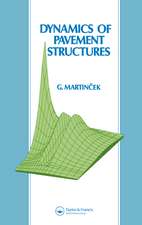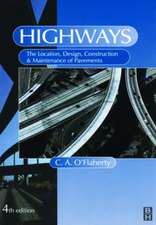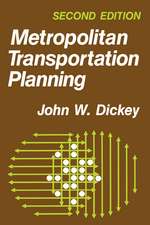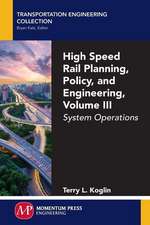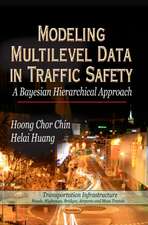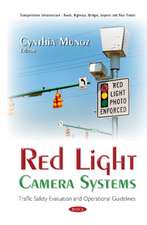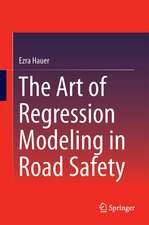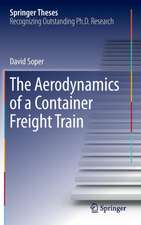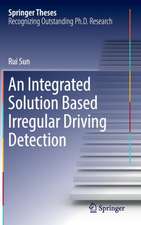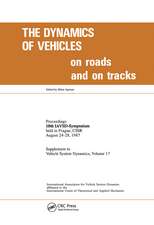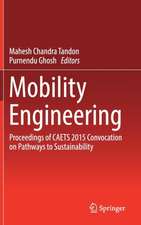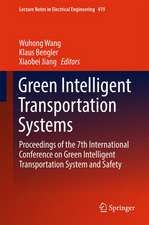Road Tunnels: An Analytical Model for Risk Analysis: SpringerBriefs in Applied Sciences and Technology
Autor Fabio Borghetti, Paolo Cerean, Marco Derudi, Alessio Frassoldatien Limba Engleză Paperback – 8 apr 2019
Din seria SpringerBriefs in Applied Sciences and Technology
-
 Preț: 415.18 lei
Preț: 415.18 lei - 17%
 Preț: 360.33 lei
Preț: 360.33 lei -
 Preț: 376.22 lei
Preț: 376.22 lei -
 Preț: 356.45 lei
Preț: 356.45 lei -
 Preț: 141.23 lei
Preț: 141.23 lei - 20%
 Preț: 326.28 lei
Preț: 326.28 lei -
 Preț: 379.09 lei
Preț: 379.09 lei -
 Preț: 195.87 lei
Preț: 195.87 lei - 20%
 Preț: 293.83 lei
Preț: 293.83 lei -
 Preț: 409.43 lei
Preț: 409.43 lei -
 Preț: 264.79 lei
Preț: 264.79 lei -
 Preț: 355.48 lei
Preț: 355.48 lei -
 Preț: 378.12 lei
Preț: 378.12 lei -
 Preț: 382.32 lei
Preț: 382.32 lei -
 Preț: 380.07 lei
Preț: 380.07 lei -
 Preț: 355.65 lei
Preț: 355.65 lei - 20%
 Preț: 225.31 lei
Preț: 225.31 lei - 20%
 Preț: 386.11 lei
Preț: 386.11 lei -
 Preț: 378.12 lei
Preț: 378.12 lei -
 Preț: 378.12 lei
Preț: 378.12 lei -
 Preț: 377.57 lei
Preț: 377.57 lei -
 Preț: 377.95 lei
Preț: 377.95 lei - 20%
 Preț: 301.85 lei
Preț: 301.85 lei - 15%
 Preț: 462.51 lei
Preț: 462.51 lei -
 Preț: 141.98 lei
Preț: 141.98 lei -
 Preț: 344.90 lei
Preț: 344.90 lei -
 Preț: 355.92 lei
Preț: 355.92 lei -
 Preț: 377.18 lei
Preț: 377.18 lei -
 Preț: 380.07 lei
Preț: 380.07 lei -
 Preț: 382.95 lei
Preț: 382.95 lei -
 Preț: 344.90 lei
Preț: 344.90 lei -
 Preț: 380.07 lei
Preț: 380.07 lei -
 Preț: 380.29 lei
Preț: 380.29 lei -
 Preț: 378.12 lei
Preț: 378.12 lei -
 Preț: 382.95 lei
Preț: 382.95 lei -
 Preț: 356.42 lei
Preț: 356.42 lei -
 Preț: 376.59 lei
Preț: 376.59 lei -
 Preț: 412.30 lei
Preț: 412.30 lei -
 Preț: 479.67 lei
Preț: 479.67 lei -
 Preț: 376.59 lei
Preț: 376.59 lei -
 Preț: 273.63 lei
Preț: 273.63 lei -
 Preț: 312.68 lei
Preț: 312.68 lei -
 Preț: 444.52 lei
Preț: 444.52 lei - 20%
 Preț: 288.73 lei
Preț: 288.73 lei -
 Preț: 381.98 lei
Preț: 381.98 lei - 20%
 Preț: 324.64 lei
Preț: 324.64 lei - 20%
 Preț: 322.17 lei
Preț: 322.17 lei -
 Preț: 410.85 lei
Preț: 410.85 lei -
 Preț: 379.68 lei
Preț: 379.68 lei -
 Preț: 374.30 lei
Preț: 374.30 lei
Preț: 379.09 lei
Nou
Puncte Express: 569
Preț estimativ în valută:
72.55€ • 74.85$ • 61.40£
72.55€ • 74.85$ • 61.40£
Carte tipărită la comandă
Livrare economică 04-18 martie
Preluare comenzi: 021 569.72.76
Specificații
ISBN-13: 9783030005689
ISBN-10: 3030005682
Pagini: 105
Ilustrații: XX, 117 p. 99 illus., 82 illus. in color.
Dimensiuni: 155 x 235 mm
Greutate: 0.2 kg
Ediția:1st ed. 2019
Editura: Springer International Publishing
Colecția Springer
Seriile SpringerBriefs in Applied Sciences and Technology, PoliMI SpringerBriefs
Locul publicării:Cham, Switzerland
ISBN-10: 3030005682
Pagini: 105
Ilustrații: XX, 117 p. 99 illus., 82 illus. in color.
Dimensiuni: 155 x 235 mm
Greutate: 0.2 kg
Ediția:1st ed. 2019
Editura: Springer International Publishing
Colecția Springer
Seriile SpringerBriefs in Applied Sciences and Technology, PoliMI SpringerBriefs
Locul publicării:Cham, Switzerland
Cuprins
Road tunnels risk analysis.- Background of modelling approaches and tools.- Model structure.- Tunnel infrastructure measures, equipment and management procedures.- Queue formation model.- Distribution model of potentially exposed users inside the tunnel.- Consequence analysis of the accidental scenarios.- Egress model for tunnel users.- Calculation of the F-N curve and the expected damage value.- Model calibration and validation.

